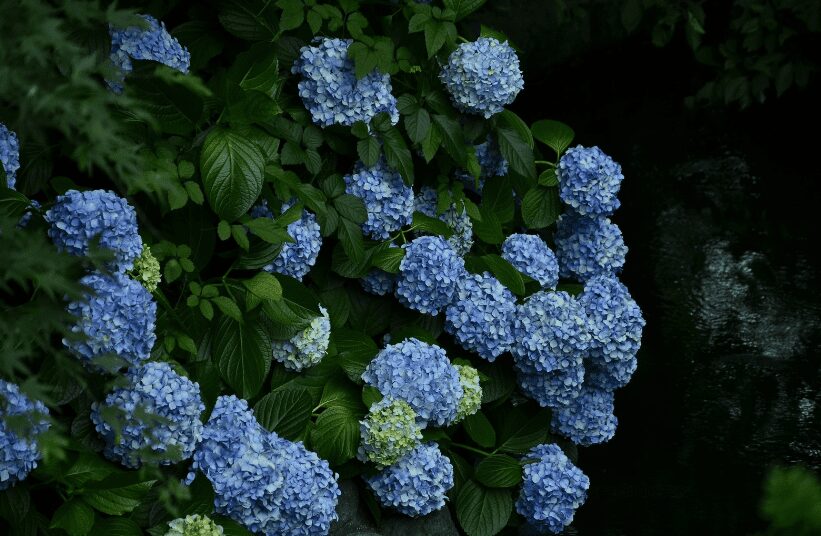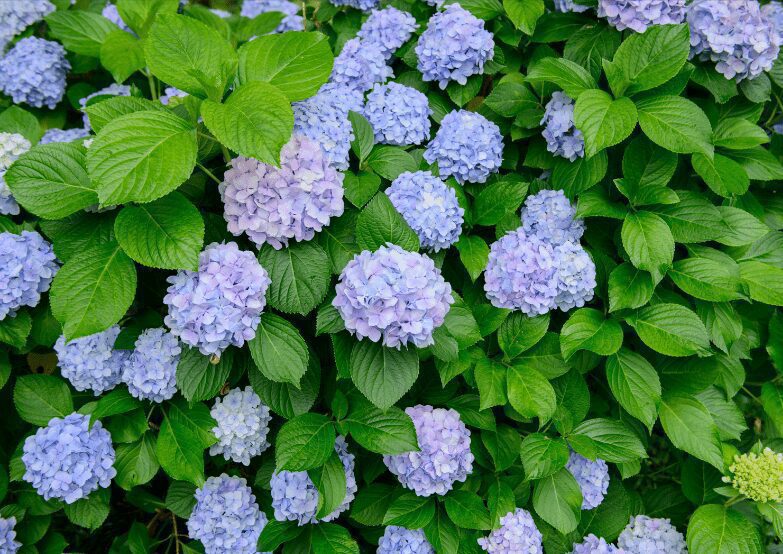
What is the secret to blue hydrangeas? The answer is acid soils with available aluminum will change pink hydrangeas to deep blues. When the planting becomes pinkish, it’s a good bet the soils are neutral or alkaline.
Make the soil more acidic and add aluminum with aluminum sulfate from garden centers.
It is applied at a rate of 2 tablespoons per plant, dissolved in 2 quarts of water, and drenched over the surface soil.
Begin with two applications equally spaced throughout the summer and one during spring before flowering to give the blue color most gardeners enjoy.
Do not over-apply the product, as aluminum can reach toxic levels in the soil.
Here Are 6 Secret Tips To Have Blue Hydrangeas
1. Select the Correct Hydrangea

Only bigleaf hydrangea (Hydrangea macrophylla) blossoms can change color. Other hydrangeas, such as oakleaf hydrangeas and smooth hydrangeas like ‘Annabelle,’ only bloom in white or cream.
These plants are just as big and lovely, but if you want blue hydrangeas, make sure you plant kinds that can change the desired shade.
2. Select Blue Variety
Look for blue hydrangeas like Nikko Blue, Endless Summer The Original, Penny Mac, Blauer Prinz, or Endless Summer Twist-n-Shout.
If the plants aren’t in bloom at the nursery, the photo on the plant tag will assist you in choosing blue-blooming kinds.
3. Determine The pH Of The Soil
While this may appear to be sophisticated chemistry, it is not. Every soil has a pH value that indicates its alkalinity or acidity.
The pH scale ranges from 0 to 14, with 7 being neutral. Acidity is indicated by soil pH values less than 7.
Alkalinity is indicated by soil pH values greater than 7. To determine the present pH levels of your soil, use a soil test kit.
4. Select Your Flower Color
Hydrangeas must be cultivated in acidic soil with a pH of 5.5 or lower to produce true blue blossoms. Pink flowering plants require neutral to alkaline soils (pH 6.5 and higher).
The pH of the soil must be between 5.5 and 6.5 for purple blooms (or a mix of blue and pink flowers on the same plant). Your soil test results will assist you in deciding what to do next.
5. Adjust the pH of the Soil
Many garden soils are neutral. Therefore, you’ll need to increase the acidity to get blue. You can accomplish this in a variety of ways. Sulfur and sulfate are examples of organic acidifiers.
Also available are simple soil additions designed exclusively for hydrangeas. Bailey’s Color Me Blue (soil sulfur) or Bailey’s Color Me Pink (garden lime) alter the pH of the soil, allowing you to experience the desired hydrangea bloom color.
With all products either acidic (for blue flowers) or alkaline the soil (for pink blooms). When planting your hydrangea, mix the pelleted mixture into the soil.
6. Maintain the acidification of the pH for Blue Blooms.
To generate dependably blue flowers, your soil pH must be regularly adjusted. Work gently, acidifying soil additives into the top layer of soil surrounding the root zone anytime you fertilize your hydrangeas, usually in early spring.
Also, if you start with alkaline or neutral soil and try to acidify it, keep in mind that your hydrangeas will not become blue overnight.
It will most likely take several treatments to get your soil acidic enough, and if your hydrangeas have already blossomed pink, you may not see blue flowers until next year.
Final Word
- What is the secret to keeping hydrangeas blue? Acid soils with available aluminum will change pink hydrangeas to deep blues. When the planting becomes pinkish, it’s a good bet the soils are neutral or alkaline.
- Make the soil more acidic and add aluminum with aluminum sulfate from garden centers.
- It is applied at a rate of 2 tablespoons per plant, dissolved in 2 quarts of water, and drenched over the surface soil.
- Begin with two applications equally spaced throughout the summer and one during spring before flowering to give the blue color most gardeners enjoy.
- Do not over-apply the product as aluminum can reach toxic levels in the soil.






















